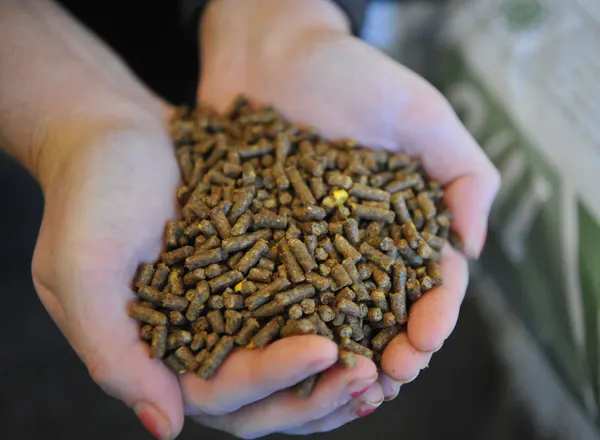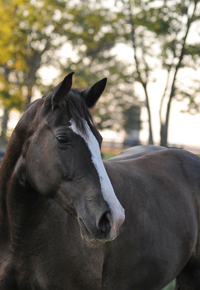I recently had the opportunity to chat with a newcomer to our farm—a tall, dark and dashing gentleman who, in a former life, was a race horse.
He’s handsome, he’s quick, and I may be in love. I gave him some tips on human management, and he helped me get in touch with the Thoroughbred side of my pedigree. He also told me about his traveling adventures to exotic places like Florida and New York, and he mentioned the great variety of hay, grains and grass he’d gotten to eat in his career.
I got to thinking about the old adage that variety is the spice of life, and it occurred to me that I’m suffering from a lack of dietary variance. I quickly ran down the list of my Human’s deficiencies, wondering if she’s just a bad cook (on top of everything else) before I remembered that Humans are only as good as their horses. How could I expect her to feed me properly without adequate training?
I usually like to have seasonal management goals for my Human—spring was all about cleaning and design of my stall, winter was about blanket quality, last fall we brought a little autumn color to her tush while I practiced my aerial movements. I decided to make sous chef training part of my summer management goals for my Human, and I immediately compiled the following training program:
Day 1: Assess your current diet’s quality. This is difficult to do if you have a stingy Human, as you obviously need a large sample to study. After you’ve eaten, pretend that you’ve forgotten you had your dinner. Take a greater interest than usual in buckets, even bath buckets. Make mournful noises, even at humans that are not yours.
ADVERTISEMENT
Hay flakes should be rooted through, making sure to examine each stem and leaf. Personally, I like to do a hay check intermittently, in which I spread the majority of the flake through my stall and pee on it. If it doesn’t absorb pee, the stems are probably too tough for my sensitive palette.
Day 2: Move on to grain testing. If your Human is like mine, she imagines a need for various powders and syrups she calls “supplements,” which are largely unnecessary. (My metabolism does NOT need a boost, thank you very much. A 54-inch girth is the new 48.) Take note of these, and see if you can discern which ones she thinks are the most important/expensive.
There are several methods for testing grain. Personally I like to bolt it down as if there is no tomorrow. This is so that I A.) experience it at its freshest, and B.) I can feel the burst of flavors more dramatically as they speed over my tongue.
Another option, particularly if you find your grain unsatisfying, is to roll it around in your mouth, then spit it onto the rubber mat or a bare space of ground to see if it clusters or bounces. Make sure to do this in view of the Human so she can see the error of inferior grain quality.
Days 3-7: Begin making your opinions known. Depending on which parts of your diet you feel are unacceptable, your tactics for this will vary. If your hay is less than stellar quality or the alfalfa ratio is off, begin disposing of it. I like to drown inappropriate hay in my water buckets, but I also recommend dumping it out windows, stringing it over salt block holders, or shoving it under stall guards.
ADVERTISEMENT
Learn which meal contains the most expensive supplements and begin skipping this meal. This is a drastic tactic, which means you’ll have to increase your grazing speed. Don’t get too regimented about this technique—leave your grain completely untouched for a couple of days, or long enough that your Human begins taking your temperature, hyperventilating, calling The Dastardly Vet or whining at your stablemates’ Humans.
Sidenote on water: You can use the “indulge in the paddock” approach for this too, until your Human learns the dust/slime to water balance that you prefer. Personally, I enjoy both freshly-scrubbed buckets and week-old ones that provide that vintage distillery taste; anything in between is really best suited for watering the lawn. Plus, it’s hilarious watching my person flip out about hydration levels.
Hopefully, your Human will take the hint and begin adding good quality sugars to your grain. I had to pick at my food for a full two weeks before my dimwit figured it out, but I was able to sample a variety of brands of applesauce, beer, cookies, molasses, and dissolved peppermints by mid-summer, and I feel my palate has benefitted tremendously. I can however, tell the difference between “reduced fat,” original and organic applesauce; I’m sure you can guess which option I prefer. Finally, I know what the Food Network critics are talking about!
Days 8 And Forward: Do remember to eventually even out your eating patterns again; Humans are creatures of habit, and if you become predictably picky, they are likely to get frustrated and stop providing you with variety. Begin devouring your previously skipped meal with fervor, especially if nothing has been changed about its content in several days. Then resume eating as normal, but don’t forget to throw in a few anorexic flags every now and then, just to keep your Human on her toes.
Does your horse have a question for Jitterbug? Send emails to her at JitterbugCOTH@gmail.com, and she will do her best to answer them in a future column.
|
|
Jitterbug is a Michigan-bred Professional Draft Cross who skillfully avoided saddles until age 5. Since then, she has been lauded for her talent in successfully managing humans while training herself to one day achieve eventing greatness. Jitter and her human live in central Kentucky. Photo by Dark Horse Photography. |
















